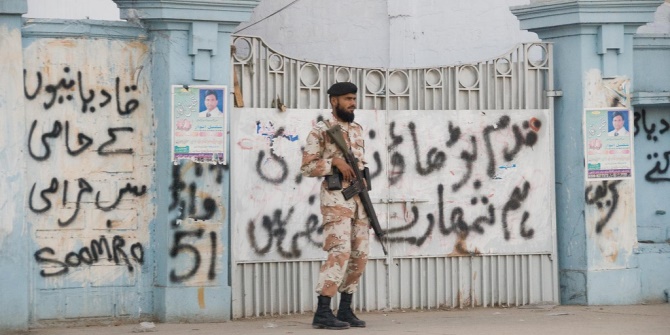As India celebrates its Independence Day, Shruti Kapila (University of Cambridge) discusses how historical time in political time holds one key to understanding India’s experience of national identity.
Dates, we are told, are important to historians. Yet they are easily far more important to statesmen and politicians as they orient memories and transform the ordinary unfolding of time into stately celebrations or solemn commemorations.
On 15 August 2020, as India firmly enters the middle years of her eighth decade as a free nation, the play between expectation and experience remains evenly poised. As a date, it evokes a mixture of pride and regret. The memory of catastrophic violence that accompanied the moment of freedom, despite the decades, remains potently alive. Pointedly, the date is a reminder of India’s subjugation as the date was chosen by the British Empire to finally quit India. Little wonder then that full-throttled state celebrations and national pageantry are rolled out only in January, on her Republic Day, to mark the country as truly free.
More than individual dates, the horizon of time certainly frames the regime of history. As Christopher Clark’s recent Time and Power demonstrates, time is a political category that orients regimes as it empowers its narratives. Each regime, as he convincingly shows for modern Germany, is marked by a distinct texture and experience of time. Nations have long privileged territory as their fundamental principle; the orientation and disposition towards time, however, has made and marred political regimes.
A deep ambivalence towards time has defined modern India. As grandly ancient yet today with the youngest population in the world, India’s vast temporal horizon defies any easy straitjacket. Is India weighed by the past in all its gore and glory? Or does India symbolise the future?
India’s founding fathers did not ignore this paradox and expended considerable effort in addressing this question. As he surveyed the newly excavated Harappa sites, India’s first Prime Minister Jawaharlal Nehru initially marvelled at the complex drainage system and city-planning of its most ancient inhabitants. But that wonder soon gave way to a deep frustration as Nehru noted that even in its most pre-historic incarnation, India was fully formed and developed. As a self-conscious maker of her destiny, Nehru focused his actions on injecting dynamism and energy as he took India to a fully mature and all-knowing entity. Science, thus, for Nehru was not merely the antidote to religion, but it crucially carried the power of novelty that alone could revivify India.
Nehru was not alone in addressing India’s identity in terms of its temporal horizon. The inventor and ideologue of Hindutva, Vinayak Savarkar’s final book was a sweeping historical account of India. Like Nehru’s Discovery of India, Savarkar’s Six Glorious Epochs synthesised the two-millennial historical expanse of India into a pithy idea. For him, the long periods of stasis and equilibrium in India were punctuated only by violent confrontation. War alone provided dynamism to India’s otherwise long and stagnant temporal plot. Thus, for Savarkar, six confrontations defined and moulded India’s identity over two thousand years. For Nehru, on the other hand, the staggering scale of India’s temporal horizon posed a significant challenge as change tended to go unnoticed for even the most dangerous elements were domesticated in her fold.
Nehru and Savarkar though political antagonists were, however, united in their disposition to time as primarily historical; both steered clear of the chronotopes of Hindu myths, epics and legends.
In this crucial respect, Savarkar was entirely unlike K. M. Munshi, his colleague in the Hindu Mahasabha. Munshi was easily the most influential proponent of a new kind of attitude that reckoned India through deep time. He laboured to make the most remote and distant past as proximate and present. Remembered primarily for his role in erecting the temple at Somnath, Munshi was a prolific writer who gave Hindu myths, epics and legends a historical carapace, a style similar to the widely consumed historical graphic novellas of Amar Chitra Katha in which fact, fiction, myth and legend mix freely.
Munshi was closer in his orientation to the first-generation British scholar-officials for whom India’s past was golden and glorious. In mining Sanskrit texts that were often collected as part of pillage and booty in imperial wars for supremacy, their engagement with the past was to forge a purpose for the present. As Sanskrit scholarship became the initial alibi for empire, the British accounted their presence in terms of a noble mission to revive and renew India’s Hindu past.
The most recent and also the most significant intervention in India’s deep time and mythological scape has been determined by the law. The erection of the Ram Temple in Ayodhya at the same spot as where a Mughal mosque once stood was ultimately sanctioned by the country’s highest court. On 5 August, as India’s Prime Minister laid the foundation stone for the temple, the expansive grandeur of long and deep time in India was dubbed anew as Bharat. It would be erroneous to see this anointment of Bharat as a homage to the past that predated India the republic. Instead, it is a monumental landmark and symbol that now points firmly to India’s future.
The anticipation of the future through historical writing is a singular hallmark of modern India’s political thought. For a century now, political ideas in India have primarily been conveyed in the historical register. This prognostic form and disposition towards time distinguishes the historical writings by political actors from that of the professional historian. As with the recent call to Bharat, or even with Savarkar or Nehru’s historical writings, each captures India’s future. Though fundamentally opposed, Savarkar and Nehru’s works had the markings of a utopia, however positive or negative. Thus, the state’s investment in dates and history is entirely predictable and potently political.
Instructively, India’s most influential political actor, and the Father of the nation, Mahatma Gandhi, had no time for history which he associated with violence alone. Gandhi abandoned history to face the future fearlessly to remake India. In so doing, Gandhi above all, made history.
This article gives the views of the authors, and not the position of the South Asia @ LSE blog, nor of the London School of Economics
Featured photo: Indian flag on bricks Credit: David_Peterson, Pixabay.







